Master the intricacies of Our Environment, Chapter 13 of Class 10 Science, with our comprehensive Important Questions Answers knowledge bank. This meticulously crafted resource encompasses all the essential concepts and topics covered in the chapter, ensuring you are well-equipped to tackle any question that may arise.
In addition to the textbook questions, we have included extra questions to challenge your understanding and prepare you for the upcoming CBSE 2024-25 board exams. To further enhance your learning experience, we have compiled a downloadable PDF version of the questions and answers, allowing you to study anytime, anywhere.
Embrace simplified environmental science and propel your exam preparation to new heights with our Our Environment Class 10 Comprehensive Q&A Knowledge Bank.
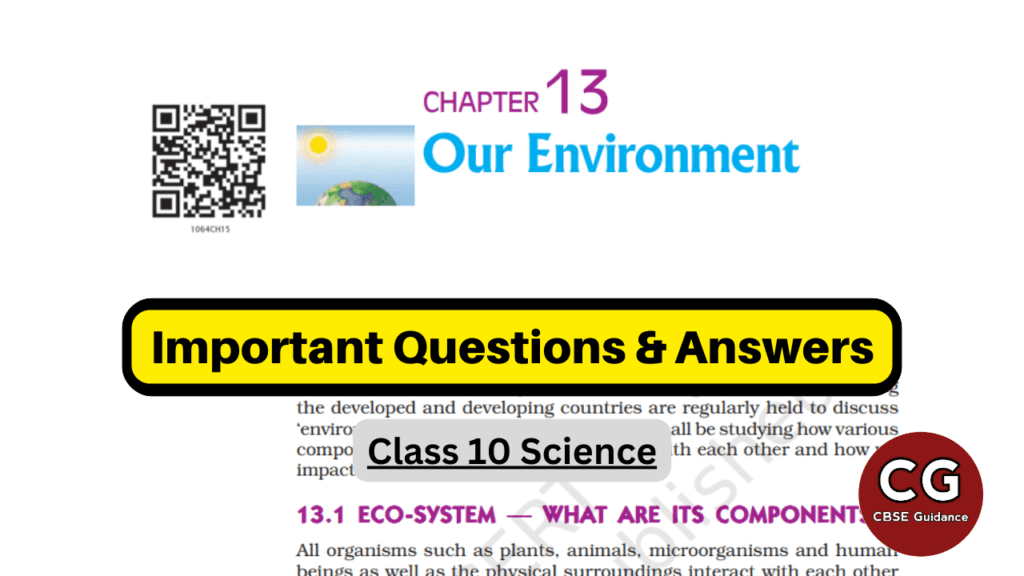
| Subject | Science |
| Class | 10 |
| Board | CBSE & State Boards |
| Chapter No. | 13 |
| Chapter Name | Our Environment |
| Type | Important Questions & Answers |
| Session | 2024-25 |
"The greatest glory in living lies not in never falling, but in rising every time we fall."
- Nelson Mandela
Our Environment Class 10 Questions Answers
Q. No. 1) Multiple Choice Questions (MCQs)
i. Which of the following organisms convert organic material to inorganic forms?
a. Producers
b. Herbivores
c. Carnivores
d. Decomposers
Ans. Option (d)
ii. If a deer is eaten by a tiger, then the energy transfer will be from
a. Producer to decomposer
b. Producer to primary consumer
c. Primary consumer to secondary consumer
d. Secondary consumer to environment
Ans. Option (c)
iii. In the given food chain, suppose the amount of energy at the fourth trophic level is 5 kJ, what will be the energy available at the producer level?
Grass → Grasshopper → Frog → Snake → Hawk
a. 5 kJ
b. 50 kJ
c. 500 kJ
d. 5000 kJ
Ans. Option (d)
iv.
- Assertion: The food chain is responsible for the entry of harmful chemicals into our bodies.
- Reason: The length and complexity of food chains vary greatly.
Options
a. Both A and R are true, and R is the correct explanation of the assertion.
b. Both A and R are true, but R is not the correct explanation of the assertion.
c. A is true, but R is false.
d. A is false, but R is true.
Ans. Option (b)
v.
- Assertion: A greater number of individuals are present in lower trophic levels.
- Reason: The flow of energy is unidirectional.
Options
a. Both A and R are true, and R is the correct explanation of the assertion.
b. Both A and R are true, but R is not the correct explanation of the assertion.
c. A is true, but R is false.
d. A is false, but R is true.
Ans. Option (b)
vi. What will happen if deer is missing from the food chain given below?
Grass → Deer → Tiger
a. The population of tigers increases
b. The population of grass decreases
c. Tiger will start eating grass
d. The population of tigers decreases and the population of grass increases
Ans. Option (d)
vii. The chemicals that are non-degradable, get progressively accumulated at each trophic level, and their concentration is seen maximum in the bodies of top consumers. This phenomenon is known as:
a) Eutrophication
b) Pollution
c) Accumulation
d) Biomagnification
Ans. Option (d)
viii. In 1987, an agreement was formulated by the United Nations Environment Programme (UNEP) to freeze the production of “X” to prevent the depletion of “Y”. “X” and “Y” respectively referred to here are:
a) Ozone; CFCs
b) CFCs; rays UV
c) CFCs; Ozone
d) UV rays; Diatomic oxygen
Ans. Option (c)
ix. Which of the following features relates to biodegradable substances?
a) Broken down by biological processes
b) Remain inert
c) Persist in the environment for long time
d) May harm the ecosystem
Ans. Option (a)
x. Assertion Reason Based Question
- Assertion: Biodegradable substances result in the formation of compost and natural replenishment.
- Reason: It is due to the breakdown of complex inorganic substances into simple organic substances.
a) Both A and R are true, and R is the correct explanation of A.
b) Both A and R are true, and R is not the correct explanation of A.
c) A is true but R is false.
d) A is false but R is true.
Ans. Option (c)
Q. No. 2) Case-based Questions
I. Read the following and answer the questions.
Food chains are very important for the survival of most species.
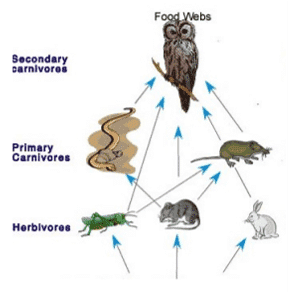
i. If 10,000 J solar energy falls on green plants in a terrestrial ecosystem, what percentage of solar energy will be converted into food energy?
a. 10,000 J
b. 100 J
c. 1000 J
d. It will depend on the type of the terrestrial plant
Ans. Option (b)
ii. If Ravi is consuming curd/yogurt for lunch, which trophic level in a food chain he should be considered as occupying?
a. First trophic level
b. Second trophic level
c. Third trophic level
d. Fourth trophic level
Ans. Option (c)
iii. The decomposers are not included in the food chain. The correct reason for the same is because decomposers:
a. Act at every trophic level of the food chain
b. Do not break down organic compounds
c. Convert organic material to inorganic forms
d. Release enzymes outside their body to convert organic material to inorganic forms
Ans. Option (a)
iv. Matter and energy are two fundamental inputs of an ecosystem. Movement of
a. Energy is bidirectional and the matter is repeatedly circulating
b. Energy is repeatedly circulation and the matter is unidirectional
c. Energy is unidirectional and the matter is repeatedly circulating
d. Energy is multidirectional and the matter is bidirectional
Ans. Option (c)
v. Which of the following limits the number of trophic levels in a food chain?
a. Decrease in energy at higher trophic levels
b. Less availability of food
c. Polluted air
d. Water
Ans. Option (a)
II. Read the following and answer the questions.
Observe the food web and answer the questions given below:
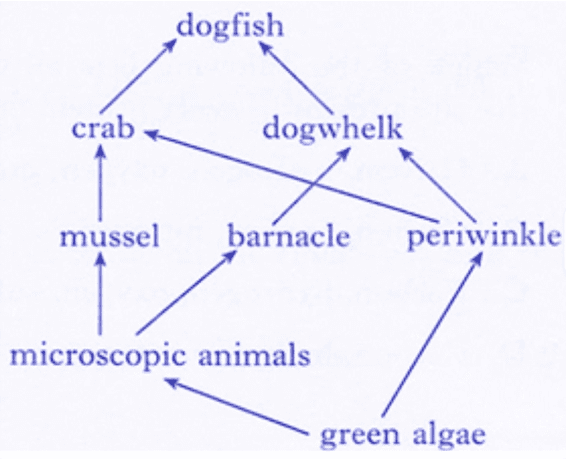
i. The mussel can be described as
a. Producers
b. Primary consumer
c. Secondary consumer
d. Decomposer
Ans. Option (c)
ii. Which trophic level is incorrectly defined?
a. Carnivores – Secondary or tertiary consumers
b. Decomposers – microbial heterotrophs
c. Herbivores – primary consumers
d. Omnivores – molds, yeast, and mushrooms
Ans. Option (d)
iii. The given figure best represents:
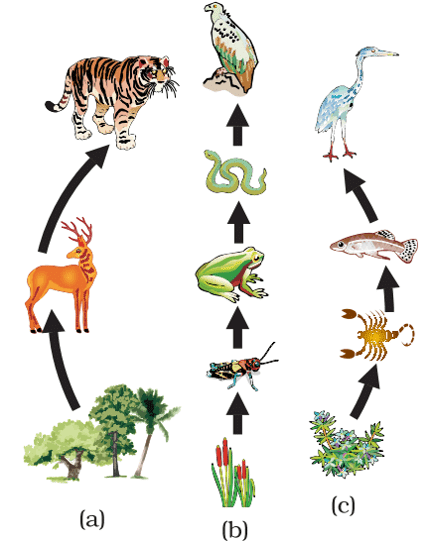
a. Food chain in forest, pond, and grassland
b. Food chain in grassland, pond, and forest
c. Food chain in forest, grassland, and pond
d. Food chain in pond, forest, and grassland
Ans. Option (c)
iv. Why do all food chains start with plants?
a. Because plants are easily grown
b. Because plants are nutritious
c. Because plants can produce their own energy
d. Because plants do not require energy
Ans. Option (c)
v. In the food web, what two organisms are competing for food?
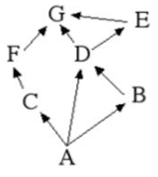
a. A and B
b. D and F
c. A and C
d. B and D
Ans. Option (d) [B and D are present at the same trophic level. They consume the same organisms and thus compete for food. C and D are also competing for food but it is not in the options.]
Q. No. 3) What is an ecosystem?
Ans. Ecosystem: All the interacting organisms in an area together with the non-living constituents of the environment form an ecosystem. An ecosystem consists of biotic components comprising living organisms and abiotic components comprising physical factors like temperature, rainfall, wind, soil, and animals.
Types of Ecosystems:
- Natural ecosystem: Forests, ponds, and lakes.
- Human-made (artificial) ecosystem: Gardens, aquariums, and crop fields.
Q. No. 4) How will you create an artificial aquatic ecosystem, which is self-sustainable?
Ans. Preparation of a self-sustainable artificial aquatic ecosystem:
- Take a large jar filled with water.
- Provide oxygen through an oxygen pump (aerator) and fish food that is available in the market.
- Add aquatic plants and animals.
- Aquatic plants/Producers provide O2 during photosynthesis.
- Aquatic animals/Consumers release CO2 for the process of photosynthesis.
- Decomposers are also important for the natural cleaning of the aquarium.
Q. No. 5) What is the role of decomposers in the ecosystem?
Ans. Role of decomposers in an ecosystem are:
- They clean the environment.
- They decompose biodegradable substances into useful substances.
- They release nutrients into the soil by decomposing dead and decaying matter, thus making the soil fertile.
- They maintain the nutrient pool by returning the nutrients in the pool.
Q. No. 6) What is the 10 percent law?
Ans. 10 percent law: Only 10% of energy is transferred to the next trophic level. The remaining 90% of energy is used in life processes (digestion, growth, reproduction, etc.) by the present trophic level.
Q. No. 7) a. Create a terrestrial food chain depicting four trophic levels.
b. Give a reason why a food chain cannot have more than four trophic levels.
Ans. a. Plant → Grasshopper → Frog → Snake
b. According to the 10% law, the amount of energy available will not be sufficient for the survival of the organism in the 5th trophic level.
Q. No. 8) The flow of energy between various components of the environment has been extensively studied. List four findings.
Ans. The flow of energy between trophic levels:
- The flow of energy is unidirectional.
- Terrestrial plants take about 1% of the Sun’s energy and change it to chemical energy.
- A great deal of energy is lost as heat/is used for digestion/ doing work/ growth and reproduction.
- An average of 10% of the food eaten is turned into its own body and made available for the next level of consumers.
- Food chains are mainly of 3-4 trophic levels (because of the 10% law).
- The number of producers is maximum and the number reduces in subsequent trophic levels.
- Food webs are more common as compared to isolated food chains.
- Biological magnification can be observed.
Q. No. 9) Indicate the flow of energy in an ecosystem. Why is it unidirectional? Justify.
Ans. The flow of energy generally is Sun → Producer → Hervibore → Carnivore. Since the flow is progressively from one trophic level to another and does not revert back, it is said to be unidirectional. Further, the available energy decreases in the higher trophic levels making it impossible for energy to flow in the reverse direction.
Q. No. 10) Give the difference between a food chain and a food web.
Ans.
| Food Chain | Food Web |
| i. Food chain is a series of organisms feeding on one another. | i. Food web consists of a number of interlinked food chains. |
| ii. Members of higher trophic level feed upon a single type of organism of the lower trophic level. | ii. Members of higher trophic levels can feed upon organisms of the lower trophic levels of other food chains. |
| iii. It does not have any effect on improving the adaptability and competitiveness of the organism. | iii. It improves the adaptability and competitiveness of the organism. |
| iv. Example: Grass → Grasshopper → Frog → Snake → Hawk. | iv. Example: A hawk might also eat a mouse, a frog, or some other animal. The snake may eat a beetle, a caterpillar, or some other animal. |
Q. No. 11) In the following food chain, vertical arrows indicate the energy lost to the environment and horizontal arrows indicate energy transferred to the next trophic level.
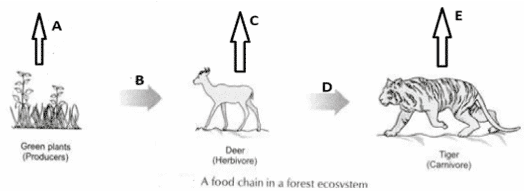
Which one of the three vertical arrows (A, C, and E) and which one of the two horizontal arrows (B and D) will represent more energy transfer? Give a reason for your answer.
Ans. A will represent more energy transfer as compared to C and E.
B will represent more energy transfer as compared to D.
When green plants are eaten by primary consumers (here Deer), a great deal of energy (here represented by A) is lost as heat to the environment, some amount goes into digestion and in doing work and the rest goes towards growth and reproduction. An average of 10% of the food eaten is made available for the next level of consumers. This loss of energy takes place at every trophic level.
Q. No. 12) Study the food web shown below.
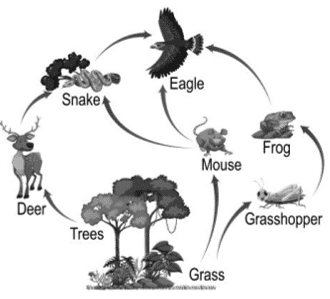
a. Identify and write the food chain from the food web shown, in which the eagle will receive the highest percentage of the energy from the producers.
b. Which organism will be the most affected when a non-biodegradable pesticide is introduced into the soil? What is the phenomenon responsible for this called?
Ans. a. Grass → Mouse → Eagle.
b. The eagle will be the most affected.
Biomagnification (Accumulation of non-biodegradable pesticides in the food chain in increasing amounts at each higher trophic level is known as biomagnification).
Q. No. 13) “Vegetarian food habits can sustain a larger number of people.” Justify the statement in terms of the food chain.
Ans. Vegetarian food habits involve a two-step food chain, i.e., producers to herbivores. According to the 10% law, energy flows from one trophic level to another. So vegetarians get more energy than non-vegetarians. More energy in the producer plants can feed a larger number of people. Thus, vegetarian food habits can sustain a larger number of people.
Q. No. 14) DDT was sprayed in a lake to regulate the breeding of mosquitoes. How would it affect the trophic levels in the following food chain associated with a lake? Justify your answer.
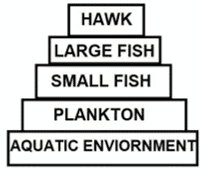
Ans. i. DDT being a non-biodegradable pesticide will enter the food chain from the first trophic level i.e., Plankton.
ii. Non-biodegradable pesticides accumulate progressively at each trophic level. This phenomenon is known as biological magnification.
iii. Hawk will have the highest level of pesticide.
Q. No. 15) The following organisms form a food chain.
Insect, Hawk, Grass, Snake, Frog.
Which of these will have the highest concentration of non-biodegradable chemicals? Name the phenomenon.
Ans. Hawk. Biomagnification.
Q. No. 16) Study the food chain given below and answer the questions that follow:
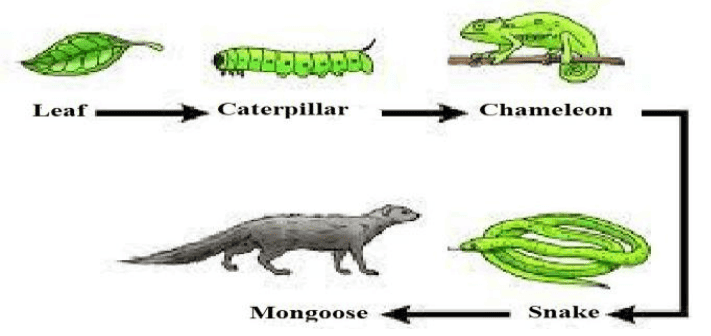
a) If the amount of energy available at the third trophic level is 100 joules, then how much energy will be available at the producer level? Justify your answer.
b) Is it possible to have 2 more trophic levels in this food chain just before the fourth trophic level? Justify your answer.
Ans. a) 10000J because only 10 % of energy is available for the next trophic level.
b) No, since the loss of energy at each step is so great that very little usable energy will remain after 4 trophic levels.
Q. No. 17) “Human beings occupy the top level in any food chain.” What are the consequences of this on our bodies?
Ans. The consequences of human beings occupying the top level in any food chain are:
- A maximum level of bio-magnification occurs here because of progressive accumulation.
- We get a very small amount of energy as only 10% of the previous energy gets transferred at each trophic level.
Q. No. 18) Gas A, found in the upper layers of the atmosphere (Stratosphere), is a deadly poison but is essential for all living beings. The amount of this gas started declining sharply in the 1980s.
a. Identify Gas A. How is it formed at higher levels of the atmosphere?
b. How is this Gas A both beneficial and damaging?
c. State the cause for the depletion of this gas. How can the depletion of this gas be prevented?
d. State any two health consequences of ozone layer depletion on human health.
Ans. a. Gas A is Ozone (O3).
Formation of ozone:
The high-energy UV radiations break down the O2 molecules into free oxygen (O) atoms.

These oxygen atoms then combine with oxygen (O2) molecules to form the ozone molecule.

b. Ozone is beneficial as it shields the surface of the earth from UV radiations of the Sun.
Ozone is damaging as it is a deadly poison.
c. Cause of Ozone depletion: Synthetic chemicals like chlorofluorocarbons (CFCs) which are used as refrigerants and in fire extinguishers lead to the depletion of the ozone layer.
Depletion of the ozone layer can be prevented by not using synthetic chemicals like CFCs, that deplete the O3 layer.
d. Two health consequences of ozone layer depletion:
- Skin Cancer
- Cataract
Q. No. 19) Why is damage to the ozone layer a cause for concern? What are its causes and what steps are being taken to limit this damage?
Ans. Damage to the ozone layer is a cause for concern because the ozone layer shields the surface of the earth from harmful UV radiations of the Sun which can:
- Cause skin cancer, aging, and corneal cataracts in human beings.
- Result in the death of many phytoplanktons that lead to increased global warming.
Causes of depletion: Synthetic chemicals like chlorofluorocarbons (CFCs) which are used as refrigerants and in fire extinguishers lead to the depletion of the ozone layer.
Steps taken to limit the damage: Many developing and developed countries have signed and are obeying the directions of UNEP (United Nations Environment Programme) to freeze or limit the production and usage of CFCs at 1986 levels.
Q. No. 20) Differentiate between biodegradable and non-biodegradable substances. Cite examples.
Ans.
| Biodegradable Substances | Non-biodegradable Substances |
| i. Substances that are broken down by biological processes are called biodegradable substances. | i. Substances that are not broken down by biological processes are called non-biodegradable substances. |
| ii. Examples – Wood, paper, etc. | ii. Examples – Plastic, DDT, etc. |
Q. No. 21) “Improvements in our lifestyle have resulted in greater amounts of waste generation.” Give two examples to support the given statement. Suggest one change that we can incorporate into our lifestyle in order to reduce non-biodegradable waste.
Ans. More use of disposable items like paper plates, plastic items, polythene, etc.
Suggestion: Reuse polythene bags, and plastic containers.
Q. No. 22) A lot of waste is generated in the neighborhood. However, almost all of it is biodegradable. What impact will it have on the environment or human health?
Ans. Excess generation of biodegradable wastes can be harmful as:
- Its decomposition is a slow process leading to the production of foul smells and gases.
- It can be the breeding ground for germs that create unhygienic conditions.
Q. No. 23) What are the problems caused by the non-biodegradable wastes that we generate?
Ans. The problems caused by non-biodegradable wastes are:
- They cause biomagnification.
- They increase pollution.
- They make the environment unclean.
- They kill useful microorganisms.
Q. No. 24) Suggest any four activities in daily life which are eco-friendly.
Or,
List three environmentally friendly practices which you would like to form a part of your daily habits giving justification for each.
Ans. Eco-friendly activities are:
- Walk or cycle for short distances to reduce the use of vehicles running on fossil fuels.
- Use both sides of the paper to reduce its use. Fewer trees will be cut to make more paper.
- Separation of biodegradable and non-biodegradable wastes.
- Gardening
- Use of gunny bags/paper bags in place of polythene/plastic bags.
- Use of compost and vermicompost in place of fertilizers.
- Harvesting rainwater, etc.
Q. No. 25) Plastic cups were used to serve tea in trains in the early days – these could be returned to the vendors, cleaned, and reused. Later, Kulhads were used instead of plastic cups. Now, paper cups are used for serving tea.
What are the reasons for the shift from plastic to kulhads and then finally to paper cups?
Ans. The reasons for the shift from plastic to kulhads and then finally to paper cups are:
- The use of plastic cups raised the concern about hygiene thus they were replaced by disposable plastic cups.
- Disposable plastic cups are non-biodegradable and harm the environment. They were thus replaced by kulhads.
- Kulhads made of clay on a large scale resulted in the loss of top fertile soil.
- Now, disposable paper cups are used because – the paper can be recycled, is biodegradable, and is an eco-friendly material that does not cause environmental pollution.
Class 10 Science Chapter 13 Our Environment NCERT Underlined PDF
| Must Read: Our Environment Class 10 Notes to get an idea of the different types of questions asked from this chapter. |
| You Might Also Like: CBSE Class 10 Notes CBSE Class 10 Important Questions and Answers |
Hope you liked these Extra Questions Answers on Class 10 Science Chapter 13 Our Environment. Please share this with your friends and do comment if you have any doubts/suggestions to share.
Excellent sir. You are really working hard for us. I have already subscribed your You tube Channel. Your last day release on Metal and Non-Metal is just awesome. Gradually you are becoming a General Teacher for all of us. Sir will you publish some more chapters in SST?
Thanks for your lovely comment. After completing science, I will be uploading sst chapters.
Sir ek doubt hai Itna Sara kaise likhe sst me abhi bahut Dar lag rha hai .
Darr ke baad Jeet hai
Great explanation
Sir Q2 I i) ka answer galat hain
(c)1000J hoga
Option b is right as plant capture only 1% energy fall on its leaves
Option b is right as plant capture only 1% energy fall on its leaves